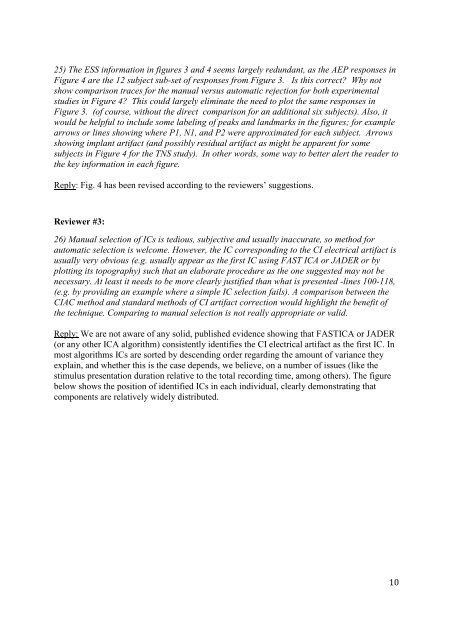Elsevier Editorial System(tm) for Hearing Research Manuscript Draft ...
Elsevier Editorial System(tm) for Hearing Research Manuscript Draft ...
Elsevier Editorial System(tm) for Hearing Research Manuscript Draft ...
Create successful ePaper yourself
Turn your PDF publications into a flip-book with our unique Google optimized e-Paper software.
25) The ESS in<strong>for</strong>mation in figures 3 and 4 seems largely redundant, as the AEP responses in<br />
Figure 4 are the 12 subject sub-set of responses from Figure 3. Is this correct? Why not<br />
show comparison traces <strong>for</strong> the manual versus automatic rejection <strong>for</strong> both experimental<br />
studies in Figure 4? This could largely eliminate the need to plot the same responses in<br />
Figure 3. (of course, without the direct comparison <strong>for</strong> an additional six subjects). Also, it<br />
would be helpful to include some labeling of peaks and landmarks in the figures; <strong>for</strong> example<br />
arrows or lines showing where P1, N1, and P2 were approximated <strong>for</strong> each subject. Arrows<br />
showing implant artifact (and possibly residual artifact as might be apparent <strong>for</strong> some<br />
subjects in Figure 4 <strong>for</strong> the TNS study). In other words, some way to better alert the reader to<br />
the key in<strong>for</strong>mation in each figure.<br />
Reply: Fig. 4 has been revised according to the reviewers’ suggestions.<br />
Reviewer #3:<br />
26) Manual selection of ICs is tedious, subjective and usually inaccurate, so method <strong>for</strong><br />
automatic selection is welcome. However, the IC corresponding to the CI electrical artifact is<br />
usually very obvious (e.g. usually appear as the first IC using FAST ICA or JADER or by<br />
plotting its topography) such that an elaborate procedure as the one suggested may not be<br />
necessary. At least it needs to be more clearly justified than what is presented -lines 100-118,<br />
(e.g. by providing an example where a simple IC selection fails). A comparison between the<br />
CIAC method and standard methods of CI artifact correction would highlight the benefit of<br />
the technique. Comparing to manual selection is not really appropriate or valid.<br />
Reply: We are not aware of any solid, published evidence showing that FASTICA or JADER<br />
(or any other ICA algorithm) consistently identifies the CI electrical artifact as the first IC. In<br />
most algorithms ICs are sorted by descending order regarding the amount of variance they<br />
explain, and whether this is the case depends, we believe, on a number of issues (like the<br />
stimulus presentation duration relative to the total recording time, among others). The figure<br />
below shows the position of identified ICs in each individual, clearly demonstrating that<br />
components are relatively widely distributed.<br />
10
















